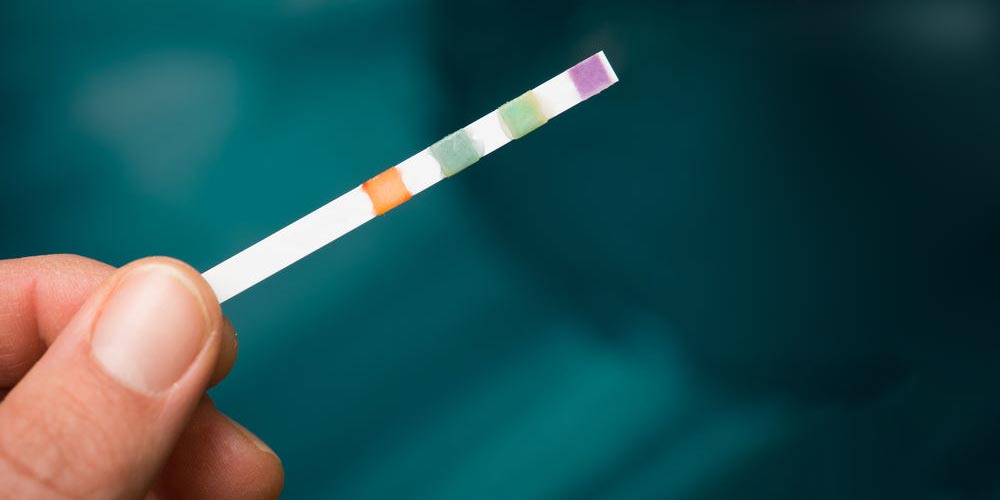
The joy a pool can give a homeowner makes the installation worth it, but maintaining a pool does require some work.
One thing you need to do is have your water tested regularly by checking pH levels, alkalinity, calcium content, and combined chlorine. You will need to find the best pool test strips to check on these levels.
Why is Testing so Important?
Testing is important because you need to know the chemical makeup of your water at all times for the following reasons:
Free Chloride Test
One thing we think you should keep an eye on is your free chloride content. You have to have just the right amount to ensure your pool can kill viruses and bacteria.
Having the right amount of free chloride also means the pool is going to be able to get rid of sweat, urine, and fecal matter that might make its way into the pool.
Failing to get rid of these things could make the water dangerous to you and your family.
Some people may be wondering what free chloride is. Well, it is compound of chlorine that is added to your pool to maintain it’s health. Think of free chloride as white blood cells for your pool.
Free chloride is there to remove pathogens or contaminants. The reason we call it free chloride is because it hasn’t attached itself to any pathogens but they are there ready to ensure your pool is safe.
One major sign you might not have enough free chlorine is algae growth.
You don’t want to see something like this growing in your pool, which ends up creating green patches on the walls or floors of your pool. These patches are not going to look nice; they are going to look ugly and feel slimy.
Now, this doesn’t mean you need to put too much chlorine in the pool because you’ll end up with irritated skin, and your pool could smell like bleach.
The scent could get so strong that it may irritate you, and no one will want to swim in that either. You want to stay between the 1.5 to 2.5 ppm range to stay safe.
Testing the pH Value
The next thing you have to do is test the pH value, which is your way of seeing how acidic your water is.
The pool water needs to be between 7.3 to 7.7 ppm, which tells you the pH value is neutral. If the number is higher than this range, the water’s alkalinity is high, and if the number is low, then the water is acidic.
Acidic water means you’ll likely feel skin and eye irritation. This also means that pool equipment is probably going to degrade the longer you leave the water this acidic.
You’ll likely see some corrosion to some of the metal parts of your pool, like your ladders or pool heater.
If the pH value is too high, then the free chlorine trying to keep you safe will not work as well as it should.
This is part of the reason we are quite adamant about making sure you are testing your water often to make sure everything is as it should be.
These are just some readings we think are important, but there’s so much more that a professional can help you monitor.
Make sure a pool specialist comes often to help you test your pool’s water, or do your best to learn how to use pool test strips.
How to Properly Use Pool Test Strips
The first thing you’ve got to do is to make sure you purchase the best pool test strips that you can.
Quality matters when it comes to the strips you get because it’ll help you get more precise readings.
Believe us, this is not something you want to mess with because your health is on the line, and the overall integrity of your pool is on the line.
One sign you are getting high-quality strips is their ease of use. A good water test strip maker isn’t going to give you something confusing that may confuse you at some point.
Good test strips are usually able to give you results pretty quickly. Don’t worry, high-quality pool water test strips are relatively inexpensive. After purchasing test strips, be sure to use them correctly.
The first thing you have to do is get the water sample from the pool itself. Make sure the container you use is completely clean before you use it to avoid any cross contamination.
The next step is to get your strip and dump it into the water. Don’t make the mistake of thinking that if you let the strip soak for a long time that you’ll get a better result. Just dunk it in the water and quickly remove the strip for the results.
Hold the strip as still as you can while watching it. Hold it and resist the urge to shake the strip a bit. You want it to stay like that for around 15 seconds; the box your strips came in is going to tell you this, too.
After that time passes, you are going to see a color show up. Check with the packaging so that you can match the color you are seeing. Now, all you have to do is make sure all your levels are where you want them to be.
If the levels aren’t where they need to be, you need to make the necessary adjustments as soon as possible for all the reasons mentioned here. We hope this guide helps you understand why testing your pool’s water is vital.
